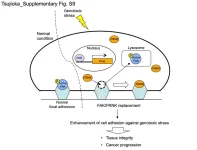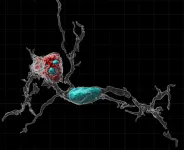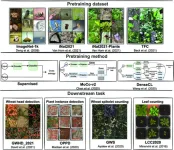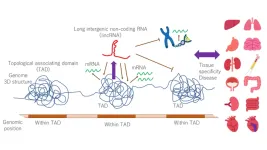(Press-News.org) The Buck Institute for Research on Aging announces that Ashley Webb, PhD, will join its faculty as an associate professor on August 1, 2023. Webb’s research is focused on the molecular mechanisms underlying stem cells and brain aging. She joins the Buck from Brown University, where she is currently an associate professor in the Department of Molecular Biology, Cell Biology and Biochemistry. Webb uses a combination of mouse models, cell culture approaches and genomics technologies to investigate the epigenetic and transcriptional mechanisms that preserve healthy cellular function and how changes in these processes impair processes in the aging brain.
Among other avenues of inquiry, the Webb lab is investigating the mechanisms that support the formation of new neurons from stem cells in the adult brain. Her team has made key discoveries on how relatively dormant stem cells in the brain accumulate damage with age and in disease models. Current funding in her lab supports the investigation of impaired neural stem cell activation in Alzheimer’s disease and the investigation of the mechanisms by which transcriptional networks support healthy brain aging and are altered in neurodegeneration.
“I am very pleased and excited to welcome Ashley to the Buck faculty,” says Buck President and CEO Eric Verdin, MD. “Her portfolio of research interests will add depth to our ongoing efforts to promote brain health as we age. Her history of cross-disciplinary collaborations makes her a perfect fit for the research culture at the Buck.”
“I am delighted to join the Buck faculty,” says Webb, who got her PhD in Molecular and Cellular Biology from the University of Washington and did her postdoctoral work at Stanford University. “My passion is to understand the molecular and cellular mechanisms that accelerate brain aging and to develop new healthspan-enhancing interventions to improve them. I am excited to take advantage of the Buck’s singular focus on aging and to work collaboratively with its outstanding faculty.”
Webb’s research interests also include sex differences in brain aging, as well as understanding aging in the hypothalamus, a structure deep in the brain which is critical to keep the body in a stable state called homeostasis. The hypothalamus regulates food intake and energy balance, sleep and circadian rhythms and various stress responses.
About the Buck Institute for Research on Aging
At the Buck, we aim to end the threat of age-related diseases for this and future generations. We bring together the most capable and passionate scientists from a broad range of disciplines to study mechanisms of aging and to identify therapeutics that slow down aging. Our goal is to increase human health span, or the healthy years of life. Located just north of San Francisco, we are globally recognized as the pioneer and leader in efforts to target aging, the number one risk factor for serious diseases including Alzheimer’s, Parkinson’s, cancer, macular degeneration, heart disease, and diabetes. The Buck wants to help people live better longer. Our success will ultimately change healthcare. Learn more at: https://buckinstitute.org
END
Brain aging expert Ashley Webb, Ph.D. joins faculty at Buck Institute for Research on Aging
2023-04-26
ELSE PRESS RELEASES FROM THIS DATE:
Study: Tree diversity increases storage of carbon and nitrogen in forest soils, mitigating climate change
2023-04-26
Preserving the diversity of forests assures their productivity and potentially increases the accumulation of carbon and nitrogen in the soil, which helps to sustain soil fertility and mitigate global climate change.
That's the main takeaway from a new study that analyzed data from hundreds of plots in Canada's National Forest Inventory to investigate the relationship between tree diversity and changes in soil carbon and nitrogen in natural forests.
Numerous biodiversity-manipulation experiments have collectively suggested that ...
Hanging on for dear life
2023-04-26
Researchers from Tokyo Medical and Dental University (TMDU) identify a novel mechanism by which cells adhere more strongly to their surrounding matrix in response to stress
Tokyo, Japan – The DNA molecules in our cells can be damaged by various extrinsic and intrinsic factors called genotoxic stressors; persistent and unchecked damage can lead to developing diseases like cancer. Fortunately, our cells don’t sit idly by and let this happen.
In a recent article published in Cell Death & Disease, a team ...
Immune system sculpts rat brains during development
2023-04-26
Researchers have established that biological sex plays a role in determining an individual’s risk of brain disorders. For example, boys are more likely to be diagnosed with behavioral conditions like autism or attention deficit disorder, whereas women are more likely to suffer from anxiety disorders, depression, or migraines. However, experts do not fully understand how sex contributes to brain development, particularly in the context of these diseases. They think, in part, it may have something to do with the differing sizes of certain brain regions.
University ...
One Health surveillance in Viet Nam highlights hotspots for viral disease emergence and calls for One Health action
2023-04-26
HA NOI, Viet Nam (April 26, 2023) – A new study led by the Wildlife Conservation Society (WCS) identified a viral hotspot in Viet Nam where bat roosting sites, bat guano harvesting, and pig farms are all in close proximity. The findings of this collaborative One Health study, described in the latest issue of the journal Viruses, have important implications for public health and wildlife conservation.
The authors say that the collection of guano – commonly used as a fertilizer – if not stopped ...
Breath test can monitor metabolism at home - study
2023-04-26
New research has found that it is possible to capture the impact of a meal on metabolism outside of a lab environment.
Published in the Journal of the International Society of Sports Nutrition and led by researchers at Anglia Ruskin University (ARU) in Cambridge, England, the study evaluated Lumen, which the manufacturers claim is the first device to allow people to monitor metabolic fuel use at home.
The research – the first applied study to investigate the practical use of this handheld breath device – was split into ...
Benchmarking deep-learning methods for more accurate plant-phenotyping
2023-04-26
In crop-breeding, plant phenotyping is the detailed study of a plant’s characteristic ‘visible’ or phenotypic features. It includes counting the number of plants generated by a crossing experiment and grading the features displayed by the offspring or progeny. The progeny with the desirable traits is then crossed to produce the next generation of crops, and the process is repeated to enhance the crop variety. Conventional methods for plant phenotyping typically lack scalability, accuracy, and are immensely labor-intensive. This imposes a certain bottleneck on crop-breeding programs.
However, with technological ...
UH-led research team seeks to improve language learning in bilingual children
2023-04-26
A University of Houston professor and her research team are seeking to improve the lives and education of bilingual children across the country through their research on developmental language disorder.
Anny Castilla-Earls, professor of communication sciences and disorders, was awarded $3.27 million for five years by the National Institute on Deafness and Other Communication Disorders to investigate the relationship between a child’s proficiency in English or Spanish and the language in which they receive treatment for developmental language disorder. Developmental language disorder, or ...
Astronomers image for the first time a black hole expelling a powerful jet
2023-04-26
An international team of scientists led by Dr. LU Rusen from the Shanghai Astronomical Observatory (SHAO) of the Chinese Academy of Sciences has used new millimeter-wavelength observations to produce an image that shows, for the first time, both the ring-like accretion structure around a black hole, where matter falls into the black hole, and the black hole's associated powerful relativistic jet. The source of the images was the central black hole of the prominent radio galaxy Messier 87.
The study was published in Nature on April 26.
The image underlines for the first time the connection between the accretion flow near the central supermassive black hole and the origin ...
LincRNA paints a target on diseased tissues
2023-04-26
Our genetic code includes over 15,000 specific sections that can be made into molecules called lincRNAs. Some of these sections can occur in coiled-up sections of our genome called TADs. LincRNAs derived from TADs appear to act as markers indicating the specific kind of tissue they are within. When something is wrong in these tissues, the markers could help with targeted medical interventions. The team that discovered this novel feature has outlined a way to apply this idea to different diseases and demonstrated it with a heart disease known as hypertrophic cardiomyopathy.
Diseases can affect very specific ...
Prehistoric poo reveals ‘waves’ of extinction in Colombia
2023-04-26
Fungal spores found in dung have revealed that large animals went extinct in two “waves” in the Colombian Andes.
Spores of coprophilous fungi pass through the guts of megafauna (animals over 45kg) as part of their life cycle, so the presence of the spores in sediment samples shows large animals lived in a certain place and time.
The study, by the University of Exeter, found that large animals became locally extinct at Pantano de Monquentiva about 23,000 years ago, and again about 11,000 years ago – with major impacts on ecosystems.
The study used ...








